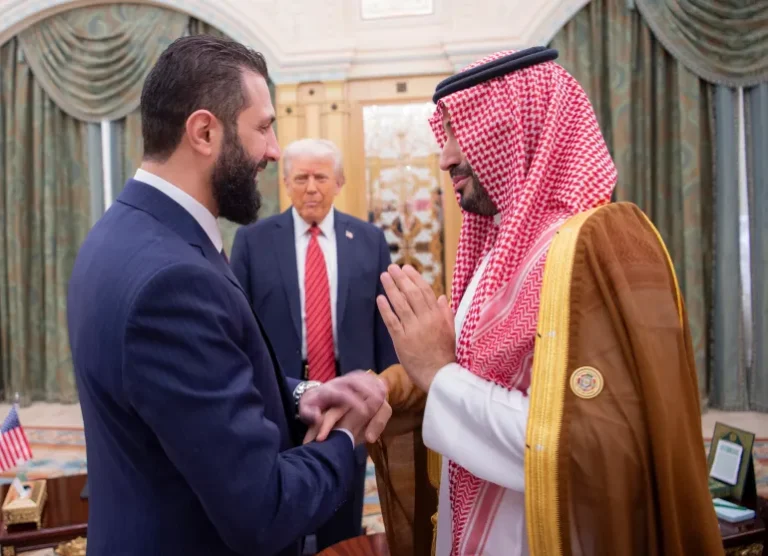President Donald Trump recently concluded a high-profile tour across the Middle East, marking his return to the region’s political stage. With strategic stops in Saudi Arabia, Qatar, and the UAE, the trip featured high-level diplomacy, military optics, and major economic announcements, along with a significant policy reversal on Syria.
Each host he visited, Trump was received with notable warmth and pageantry. Lavish ceremonies, military salutes, and state honors underscored how Middle Eastern leaders were eager to engage with the U.S. president, viewing his presence as a potential shift in regional dynamics.
Stop 1: Saudi Arabia – Rebuilding Regional Trust
Trump began his tour in Riyadh, where he met with Crown Prince Mohammed bin Salman. Their talks centered on economic cooperation, security, and countering Iran’s growing influence.
Before departing Saudi Arabia for Qatar, Trump made a historic move: he held a first-ever face-to-face meeting with Syria’s new interim president, Ahmed al-Sharaa. This marked a milestone, the first meeting between Syrian and U.S. leaders in nearly 25 years. It was especially notable because, until recently, the U.S. had placed a $10 million bounty on al-Sharaa, and his former armed group, Hayat Tahrir al-Sham (HTS), was designated a terrorist organization by Washington.
The political landscape shifted dramatically after the coalition led by HTS overthrew Syrian President Bashar al-Assad in December, ending Syria’s 13-year civil war. Al-Assad, accused of widespread human rights abuses, fled to Russia.
Sanctions Lifted from Syria
Ahead of the meeting, Trump announced the lifting of U.S. sanctions on Syria that had been imposed during al-Assad’s rule, a move praised by al-Sharaa’s government as an economic boost and a path toward regional stability.
When reporters later asked Trump about al-Sharaa, he described him as a “young, attractive guy” with a “very strong past” and “a real shot at pulling it together.”
Trump “told President Al-Sharaa that he has a tremendous opportunity to do something historic in his country”, according to a read-out from the White House. He also encouraged Syria to expel “foreign terrorists” and “Palestinian terrorists” from its borders, as well as normalise relations with Israel.
The read-out added that al-Sharaa said he shared the US’s interests in “countering terrorism and eliminating chemical weapons”. He also encouraged the US to invest in Syria’s petroleum sector.
Stop 2: Qatar – A Landmark Visit and Troop Engagement
Trump’s visit to Doha was the first official state visit by a sitting U.S. president to Qatar. His arrival was met with lavish hospitality and spectacular pageantry.
Before Air Force One even landed, it was escorted into Qatari airspace by two F-15 fighter jets as an honorary gesture. Upon touchdown, a red carpet awaited Trump, and Emir Sheikh Tamim bin Hamad Al Thani personally welcomed him. A ceremonial guard on white horses and camels accompanied his motorcade to the Amiri Diwan, Qatar’s government center.
“We’re extremely honoured to have you here. We’re very excited, very happy. It’s a historic visit,” Emir Al Thani said, emphasizing that Trump was the first American president to officially visit Qatar.
A Deal to Boost Trade and Defence
True to his nickname, “dealmaker in chief,” Trump’s visit to Qatar culminated in a major economic announcement.
The U.S. and Qatar signed deals worth at least $1.2 trillion, including Qatar Airways’ historic purchase of 210 Boeing aircraft valued at $96 billion, the largest order in Boeing’s history. Although Trump had mentioned $200 billion earlier, the finalized figure stood at $96 billion for the jet order alone.
Trump and Emir Al Thani signed the documents amid mutual expressions of friendship. The deal also included purchases of drone and anti-drone technology from U.S. defense contractors like Raytheon, along with investments in the American energy sector.
“We are going to another level of relationship between Qatar and the United States,” Emir Al Thani stated gratefully.
Stop 3: UAE – Diplomacy Meets Trillion-Dollar Deal
In Abu Dhabi, Trump was awarded the Order of Zayed, the UAE’s highest civilian honor, a gesture of exceptional hospitality and diplomatic goodwill. His meeting with Emirati leaders culminated in a $1.4 trillion investment deal into U.S. infrastructure and technology sectors.
Trump hailed the agreement as “transformational,” emphasizing that such deals showcased the UAE’s “visionary leadership” and a shared commitment to long-term economic collaboration.
Gaza as a ‘Freedom Zone’
In passing, Trump floated a provocative proposal to turn Gaza into a U.S.-controlled ‘freedom zone’, featuring luxury projects and economic zones. The vague plan, which reportedly included relocation of Gaza’s residents, was widely condemned as unethical and impractical.
Arab leaders such as Jordan’s King Abdullah II and Egypt’s President el-Sisi rejected the idea, while human rights groups warned of legal and humanitarian consequences.
Trump’s Middle East tour highlighted his administration’s focus on strengthening economic ties, reaffirming military commitments, and introducing bold policy initiatives. While the trip achieved significant diplomatic and economic milestones, proposals like the Gaza “freedom zone” sparked international debate, reflecting the complexities of U.S. involvement in the region.


